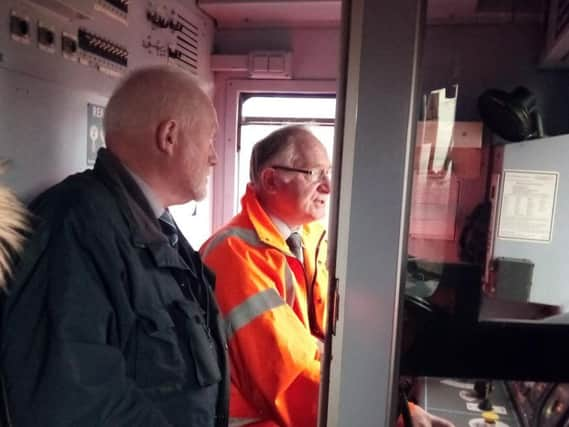WATCH: Blackpool finally on track to a 21st century railway


The monochrome print shows a tourist group at the end of the platform, steam locomotives in the background along with a maze of old-fashioned signals.Fast forward 100 years and the steam engines are long gone, as is the Victorian station building.But the signals remain almost identical to those in that fading shot of Blackpool’s glory days.“I don’t even know how long they’ve been here,” says Garry, checking the aspect as the 10.13 Blackpool to York pulls out of the station.Riding in the cab it is more clear than ever what a hotch-potch of ancient and modern Blackpool’s rail link to the rest of the UK is.All that is set to change, with Network Rail pumping millions into a revamp of the whole line.Gone will be the semaphore signals, a throwback to the previous incarnation of Britain’s privately run railways.Also gone will be the signal boxes, including the imposing Blackpool North structure which controls the station and depot beyond.The path out of Blackpool is far from simple, the train weaving across points and around curves, only beginning to properly gather speed when Layton station is in site.There’s nothing remarkable about the run to Poulton - over Carleton crossing which, once the works are completed in May next year, will be controlled not from a vantage point above the tracks but from a control centre in Manchester.Network Rail, which has a member of their own project team riding in the cab, say it will mean a more reliable railway - complicated manual structures replaced by the latest technology.And leaving Poulton, the view from the cab reveals the first signs of the revolution under way.By the side of the line are markers, blue cones similar to those which might be laid out by a football coach.Each one is the spot where a new gantry will be constructed, carrying the overhead wires which will allow electric trains to run into Blackpool for the first time.“You can see the work starting,” said Garry.“There have been people surveying, people doing other works. We can see markers being put down.“There are things happening all the time and it’s getting busier.”His point is enforced as the train rushes through Salwick where Network Rail is building a huge compound for its upgrade team.Disused tracks have been ripped up, cleared of bushes and weeds ready for works to begin.Further up the line there’s a team of trackworkers, the driver sounds the horn as the train passes - everywhere along the route the signs are clear that upgrade work is under way.On the return journey from Preston there is a perfect example of why the work is so essential.With Garry at the controls the train runs into an amber signal on the approach to Kirkham.Slowing to a crawl we are passed by a service heading east off the South Fylde line.“The problem is,” says Garry, “that if there’s a late train coming off the line the next service can’t get on.“That means everything behind gets held up too.“This is a big cause of delays and it can’t be helped.“Even when the next train is moving we can’t speed up until we’ve seen the next signal.“You don’t get sight of that until you’ve passed the platform, until then we can’t exceed 20 miles per hour, we have to be ready to stop.“It’s easy to lose five minutes or more.”Garry is right, even from the cab the all clear green signal is obscured until the train has passed through Kirkham and once clear of the Blackpool South traffic jam this service is running late.To solve the problem Network Rail is going back to the drawing board at Kirkham.A brand new platform will be built, separating main line services and branch line trains and hopefully ending the Kirkham logjam once and for all.The upgrade of the Blackpool North route has been a long time coming.Electrification was proposed way back in the 1970s, a train was even sent to Preston to do the work.But the project was shelved, the train left in a siding to rust.“You can see it’s really happening,” says Garry, as he guides the train the last few hundred metres into Blackpool.“All this is going to change, the signals, the station, the trains.”From the business end it’s easy to see not only the beginnings of the change but why it’s necessary.Outdated technology and decades-old track layouts show how minor problems can lead to major delays and why, after 30 years out on a limb, Blackpool is finally becoming part of the 21st century railway.